|
Discover the
hidden treasures of Drake Bay, Costa Rica with Tracie "The Bug Lady" .

Home

Tour
Basics

Meet the Bug
Lady

Tales from the
Edge

Media

Reservations

Links



Facts about Drake Bay, Costa Rica

Travel To Drake Bay

Drake Bay Area Map

Hotel Information

Tips for Travelers

Tours

Recommended
Reading





|
|
|
Hyalinobatrachium colymbiphyllum |
|
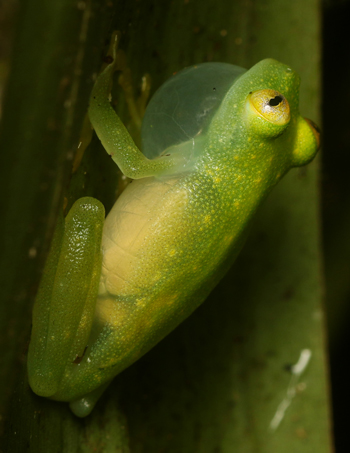 The
Cricket Glass Frog is one of the most spectacular Glass Frog species
one can hope to encounter in Costa Rica. It is a true Glass Frog
amongst Glass Frogs. The
Cricket Glass Frog is one of the most spectacular Glass Frog species
one can hope to encounter in Costa Rica. It is a true Glass Frog
amongst Glass Frogs.
It's underside lacks any pigment, as can be seen in the photograph
on the left, and all of the frog's internal organs are clearly
visible. The red heart lacks a lining and is visible near the frog's
throat.
Below the heart is the liver, which is covered by a white visceral
lining. This can be clearly distinguished on the photograph below.
The green gall bladder can be seen to the left, just below the liver
and the ventral vein points downward, from the liver towards the
digestive tract. The digestive tract, like the liver, is also
covered by a white visceral lining. The red area to the right of
this individual's gall bladder is a bit of a mystery. This area
should be white on Cricket Glass Frogs. Despite the anomaly, we have found two individuals
with the same characteristics in Drake Bay. |
|
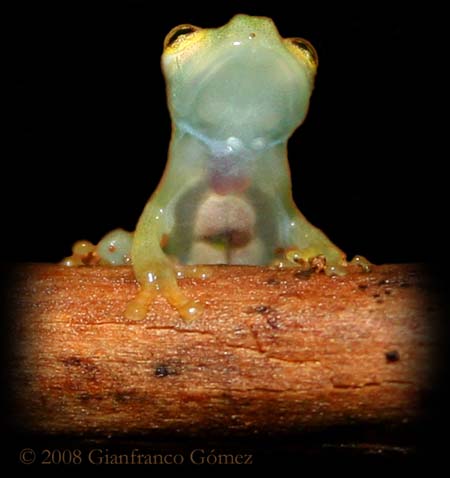 Individuals
from southwest Costa Rica have light green skin scattered with very
fine, yellow and black spots throughout their upper surface. Individuals
from southwest Costa Rica have light green skin scattered with very
fine, yellow and black spots throughout their upper surface.
According to Brian Kubicki's
Glass Frogs of Costa Rica, there is an isolated population in
Monteverde which differs in size, call, coloration and in the shape
of their egg masses. They are still classified as
Hyalinobatrachium colymbiphyllum, but Kubicki speculates that it
could be a completely different species altogether.
|
|
Cricket Glass Frogs are
uncommon and small, with adults measuring between 23 and 28
millimeters. As with other Glass Frogs, females are normally larger
than males. On
humid nights, male frogs call from the top or, more commonly, from the underside of
leaves bordering streams in primary or secondary forests. Males
generally call from one to six meters above the surface of the
stream.
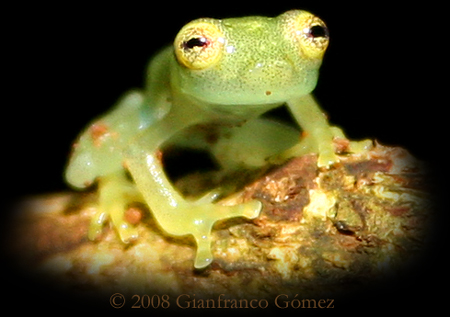
Its
common name is due to its call, described as a single note, a rather
musical "brrrrrrrt", which closely resembles that of a cricket. The
call serves to advertise to females as well as to demark the male's
territory.
Like the closely related Reticulated Glass Frog (Hyalinobatrachium
valerioi), Cricket Glass Frogs are extremely territorial. If
an intruder invades another male's territory, the confrontation
could turn physical and wrestling matches may ensue. The battle will
rage until the victor pins his opponent and holds him down for a
short time. After it is clear which frog will get to keep the calling perch, the
loser is released and will retreat to find another leaf to call
from. |
|
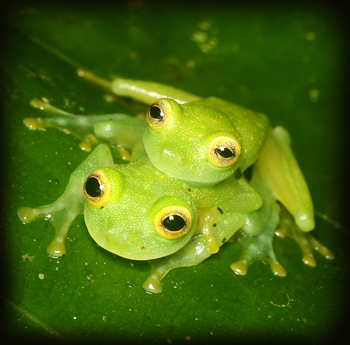 Once
a male has secured his perch, he will resume calling until he
attracts a female. The female will approach the male and they will
mate right at the calling site. She will lay her eggs on the
underside of the calling site leaf, often near its center. Egg
clutches contain between 50 and 75 eggs. Once
a male has secured his perch, he will resume calling until he
attracts a female. The female will approach the male and they will
mate right at the calling site. She will lay her eggs on the
underside of the calling site leaf, often near its center. Egg
clutches contain between 50 and 75 eggs.
After the eggs have been
deposited, the male will continue his advertising call. If another
female is drawn in by his call, they will mate and she will also lay
her eggs on the underside of his calling perch. |
|
Males will guard the eggs
during the night and individual males have been recorded guarding up
to eight egg clutches in different stages of development.
Throughout
the night, the male will occasionally climb on top of the egg
clutches and empty his bladder, protecting them from dehydration.
The
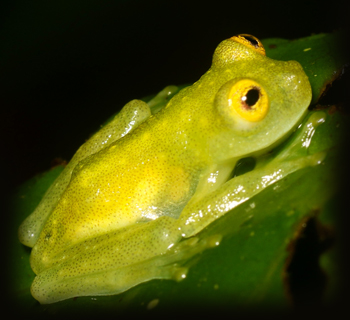 egg masses absorb the water and become noticeably
swollen. egg masses absorb the water and become noticeably
swollen.
Once dawn arrives, the males
will retreat into the canopy, leaving their egg clutches
unprotected. This results in a high mortality rate. Wasps commonly raid the egg
clutch. The eggs are carried away one by one, often until the entire egg mass is gone.
At night, the males return to their perches and resume their
post.
Cricket Glass Frogs
are only know to exist in three countries: Costa Rica, Panama, and
Colombia. |
|
References:
Kubicki, B. 2007
Costa Rica Glass Frogs
Editorial INBio
Savage, J. 2002 The Amphibians and Reptiles of
Costa Rica University of Chicago Press
|

|
|
|
|
The Frog
Files





     






 |
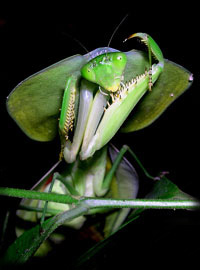


 Alien Earthlings
Alien Earthlings  The
Dark Side
The
Dark Side 











 The
Cricket Glass Frog is one of the most spectacular Glass Frog species
one can hope to encounter in Costa Rica. It is a true Glass Frog
amongst Glass Frogs.
The
Cricket Glass Frog is one of the most spectacular Glass Frog species
one can hope to encounter in Costa Rica. It is a true Glass Frog
amongst Glass Frogs.
 Individuals
from southwest Costa Rica have light green skin scattered with very
fine, yellow and black spots throughout their upper surface.
Individuals
from southwest Costa Rica have light green skin scattered with very
fine, yellow and black spots throughout their upper surface.

 Once
a male has secured his perch, he will resume calling until he
attracts a female. The female will approach the male and they will
mate right at the calling site. She will lay her eggs on the
underside of the calling site leaf, often near its center. Egg
clutches contain between 50 and 75 eggs.
Once
a male has secured his perch, he will resume calling until he
attracts a female. The female will approach the male and they will
mate right at the calling site. She will lay her eggs on the
underside of the calling site leaf, often near its center. Egg
clutches contain between 50 and 75 eggs.
 egg masses absorb the water and become noticeably
swollen.
egg masses absorb the water and become noticeably
swollen.







